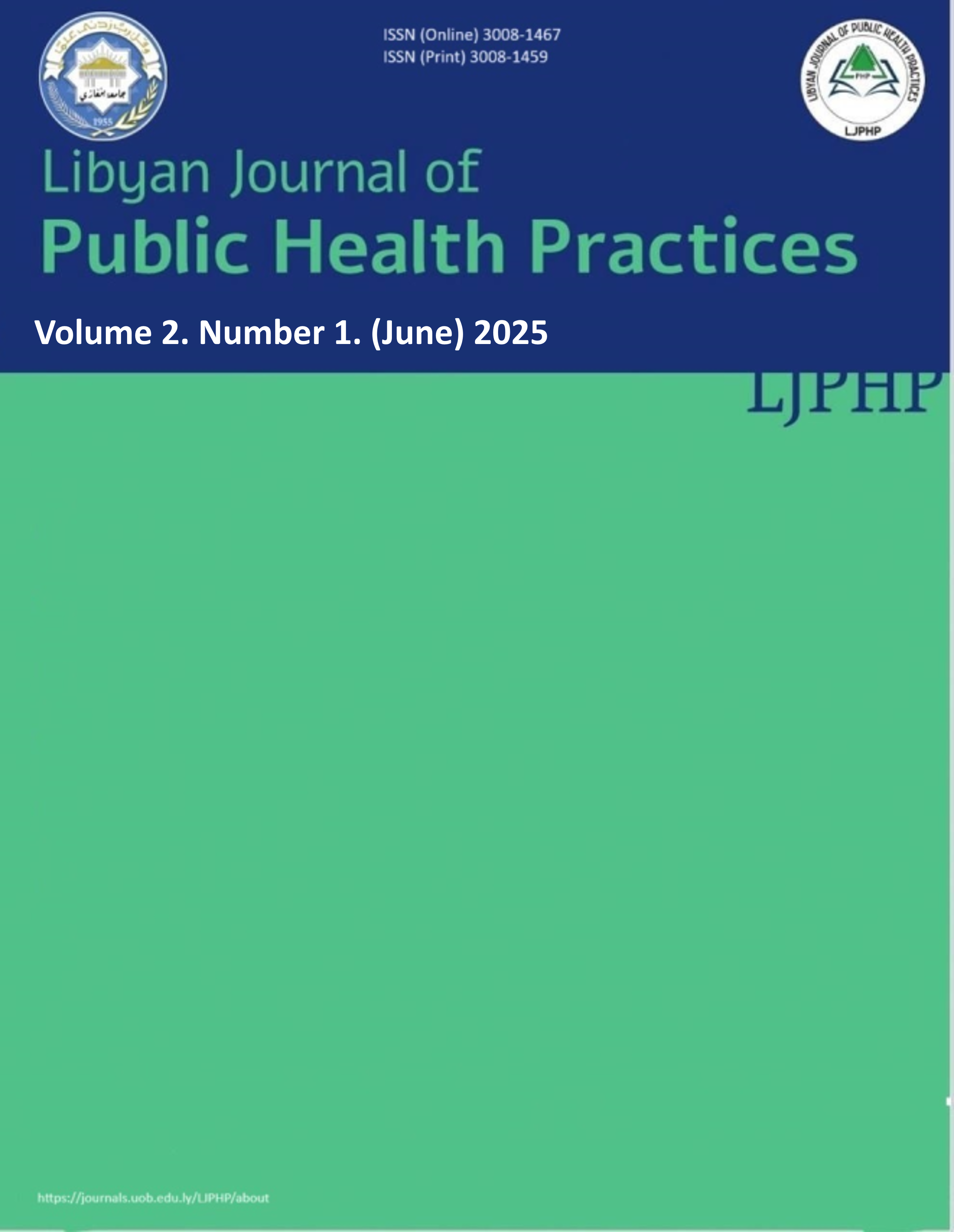Feco-prevalence of Helicobacter Pylori among symptomatic patients in Al-Marj city
DOI:
https://doi.org/10.37376/ljphp.v2i1.7345Keywords:
Helicobacter pylori, Dyspepsia, Stool antigen test, Fluorescence immunoassay, LibyaAbstract
Helicobacter pylori is a bacterium that causes infections in a significant portion of the global population. This study aimed to determine the prevalence of H. pylori infection among dyspeptic patients and to investigate its association with age and sex in Al Marj City, Libya. A cross-sectional descriptive study was conducted at Tabebouk Laboratory from January 1, 2023, to December 31, 2024, involving 495 participants. Stool samples were analysed using a fluorescence immunoassay-based technique to detect H. pylori antigens. The overall prevalence of H. pylori infection was 50.3%, with males showing a higher infection rate (54.22%) than females (45.78%). The highest prevalence was observed in young adults aged 20-45 years (49.40%), followed by middle-aged and elderly individuals (≥46 years; 36.95%). Children and teenagers had significantly lower infection rates (6.83% each). No significant sex differences were found among children and teenagers. In conclusion, H. pylori infection rates were higher in males and most prevalent among young adults aged 20–45 years. These findings highlight the need for targeted public health strategies, especially in adult populations, to improve early detection and management of H. pylori-related gastrointestinal conditions.
References
Chivu RF, Bobirca F, Melesteu I, Patrascu T. The Role of Helicobacter Pylori Infection in the Development of Gastric Cancer—Review of the Literature. Chirurgia (Bucur). 2024;119:eCollection:1-10.
Younis EZ. Helicobacter pylori infections among patients with type 2 diabetes mellitus in Benghazi, Libya. J Gastro Hepato. 2022;8:1-7.
Aguemon BD, Struelens MJ, Massougbodji A, Ouendo EM. Prevalence and risk-factors for Helicobacter pylori infection in urban and rural Beninese populations. Clin Microbiol Infect. 2005;11(8):611-617. doi:10.1111/j.1469-0691.2005.01189.x
Chang Y, Dong S, Kim H, et al. Role of Helicobacter pylori infection among offspring or siblings of gastric cancer patients. Int J Cancer. 2002;101(5):469-474. doi:10.1002/ijc.10637
Dominici P, Grilli R, Grossi E, et al. Familial clustering of Helicobacter pylori infection: population based study. BMJ. 1999;319(7209):537-541. doi:10.1136/bmj.319.7209.537
Malaty HM, Graham DY, Evans DJ, Adam EE, Klein DG. Transmission of Helicobacter pylori infection: studies in families of healthy individuals. Scand J Gastroenterol. 1991;26(9):927-932. doi:10.3109/00365529108996244
Zhou XZ, Lyu NH, Zhu HY, et al. Large-scale, national, family-based epidemiological study on Helicobacter pylori infection in China: the time to change practice for related disease prevention. Gut. 2023;72(5):855-869. doi:10.1136/gutjnl-2022-328965
Ali A, AlHussaini KI. Helicobacter pylori: a contemporary perspective on pathogenesis, diagnosis and treatment strategies. Microorganisms. 2024;12(1):222. doi:10.3390/microorganisms12010222
Hussein RA, Al-Ouqaili MTS, Majeed YH. Detection of Helicobacter pylori infection by invasive and non-invasive techniques in patients with gastrointestinal diseases from Iraq: a validation study. PLoS One. 2021;16(8):e0256393. doi:10.1371/journal.pone.0256393 P
Asenjo LM, Gisbert JP. Prevalencia de la infección por Helicobacter pylori en el linfoma MALT gástrico: una revisión sistemática. Rev Esp Enferm Dig. 2007;99(7):398-404. doi:10.4321/s1130-01082007000700006
Hooi JKY, Lai WY, Ng WK, et al. Global prevalence of Helicobacter pylori infection: systematic review and meta-analysis. Gastroenterology. 2017;153(2):420-429. doi:10.1053/j.gastro.2017.04.022
Reyes VE. Helicobacter pylori immune response in children versus adults. Med Res Arch. 2022;10(12):3370. doi:10.18103/mra.v10i12.3370
Kim N. Prevalence and transmission routes of H. pylori. In: Helicobacter pylori. Singapore: Springer Nature Singapore; 2024:3-21.
Ofori EG, Adinortey CA, Bockarie AS, Kyei F, Tagoe EA, Adinortey MB. Helicobacter pylori infection, virulence genes’ distribution and accompanying clinical outcomes: the West Africa situation. Biomed Res Int. 2019;2019:7312908. doi:10.1155/2019/7312908
Archampong TN, Asmah RH, Wiredu EK, Gyasi RK, Nkrumah KN, Rajakumar K. Epidemiology of Helicobacter pylori infection in dyspeptic Ghanaian patients. Pan African Medical Journal. 2015;20(1).
Mohammad MA, Hussein L, Coward A, Jackson SJ. Prevalence of Helicobacter pylori infection among Egyptian children: impact of social background and effect on growth. Public health nutrition. 2008 Mar;11(3):230-6.
Cho JH, Jin SY. Current guidelines for Helicobacter pylori treatment in East Asia 2022: differences among China, Japan, and South Korea. World J Clin Cases. 2022;10(19):6349-6359. doi:10.12998/wjcc.v10.i19.6349
Abdallah A, Abdallah A, Adabo H, et al. Study to determine the prevalence of Helicobacter pylori infection among the Sirte population (Libya) using an Antibody Rapid Test Cassette method. Libyan J Sci Technol. 2021;13(1). doi:10.37376/ljst.v13i1.2176
Atia A, Abuagela M, Abdulwahed E, et al. Seroprevalence of Helicobacter pylori infection in Tripoli, Libya. Mustansiriya Med J. 2023;22(1):68-70. doi:10.4103/mj.mj_57_22
Vale FF, Vitor JMB. Transmission pathway of Helicobacter pylori: does food play a role in rural and urban areas? Int J Food Microbiol. 2010;138(1-2):1-12. doi:10.1016/j.ijfoodmicro.2010.01.015
Goh KL, Chan WK, Shiota S, Yamaoka Y. Epidemiology of Helicobacter pylori infection and public health implications. Helicobacter. 2011;16(Suppl 1):1-9. doi:10.1111/j.1523-5378.2011.00874.x
Chey WD, Leontiadis GI, Howden CW, Moss SF. ACG clinical guideline: treatment of Helicobacter pylori infection. Am J Gastroenterol. 2017;112(2):212-239. doi:10.1038/ajg.2016.563
Downloads
Published
How to Cite
Issue
Section
License
Copyright (c) 2025 Libyan Journal of Public Health Practices

This work is licensed under a Creative Commons Attribution-NonCommercial-NoDerivatives 4.0 International License.












